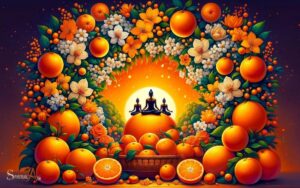Spiritual Buddhist Symbols and Meanings: Lotus Flower!
Buddhist symbols and their meanings encapsulate the essence of Buddhist teachings, each symbol serving as a guidepost to spiritual enlightenment.
These symbols range from the lotus flower, representing purity and spiritual awakening, to the endless knot, symbolizing the interconnectedness of all things.
Buddhist symbols are integral to the faith, embodying deep spiritual concepts:
Discover the profound messages within Buddhist symbols, revealing paths to inner peace and spiritual growth.
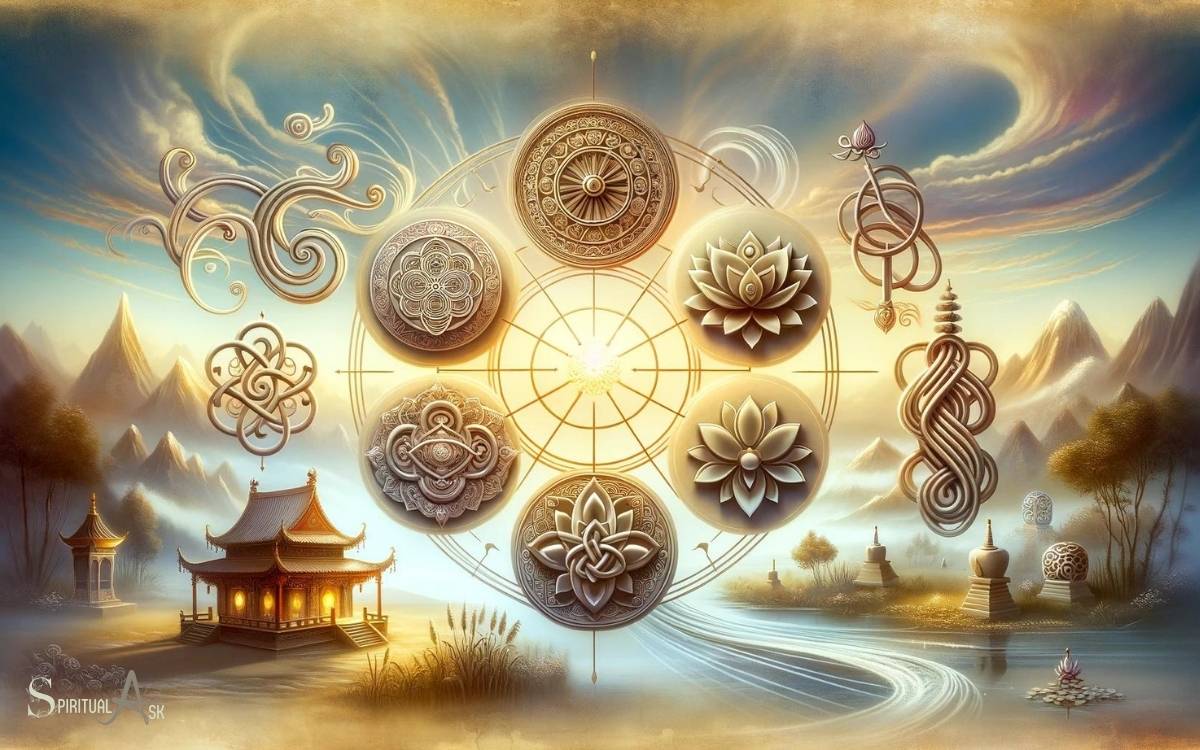
Key Takeaway
6 Spiritual Buddhist Symbols and Meanings
| Symbol | Meaning | Significance in Buddhism |
|---|---|---|
| Lotus Flower | Purity, spiritual awakening, rebirth | Rising above the murky waters to achieve enlightenment |
| Dharma Wheel | Buddha’s teachings, the path to enlightenment | The eightfold path leading to liberation |
| Endless Knot | Interconnectedness of all things, the cyclical nature of life | Unity of thought, action, and existence |
| Two Golden Fish | Happiness, freedom, fertility, abundance | The state of fearlessness and spiritual liberation |
| Parasol | Protection, royalty | Shelter from the heat of suffering, compassion |
| Conch Shell | The spread of Buddha’s teachings, awakening of disciples | The call to awaken and follow the path of Dharma |
The Lotus Flower Symbol
The lotus flower symbolizes purity and enlightenment in Buddhist tradition. Its ability to emerge from murky waters and bloom into a beautiful, untainted flower represents the journey towards spiritual awakening.
As a Buddhist, I find the lotus flower to be a powerful reminder of the potential for growth and transformation within each of us.
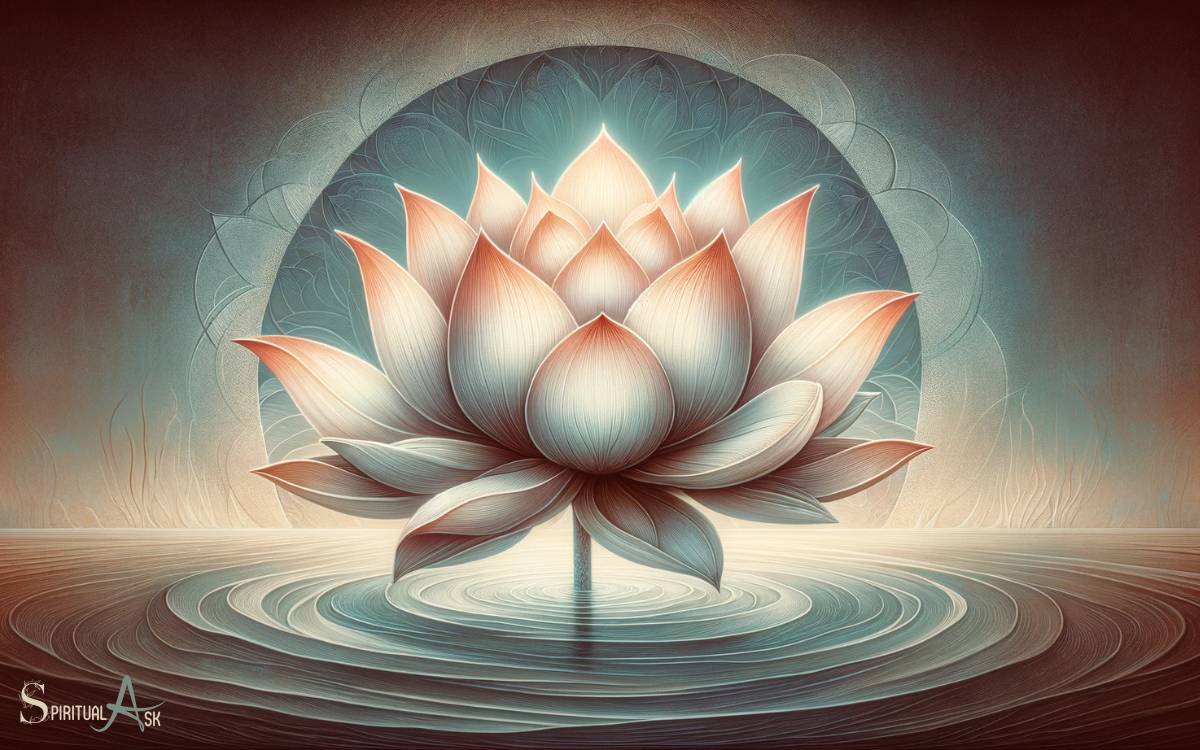
The different stages of the lotus, from the muddy pond to the fully bloomed flower, mirror our own personal development and the struggles we face along the way.
It serves as a beacon of hope, encouraging us to rise above challenges and ultimately find inner peace and enlightenment.
The lotus flower’s symbolism is a source of inspiration for many, reminding us that even in the darkest of times, there is potential for beauty and enlightenment.
The Dharma Wheel
Upon encountering the Dharma Wheel, I was immediately struck by its profound symbolism and significance in Buddhism. The wheel, also known as the Dharmachakra, represents the teachings of the Buddha.
Its circular shape symbolizes the completeness and continuity of these teachings, which guide followers on the path to enlightenment. The hub of the wheel signifies discipline and mental concentration, essential for spiritual progress.
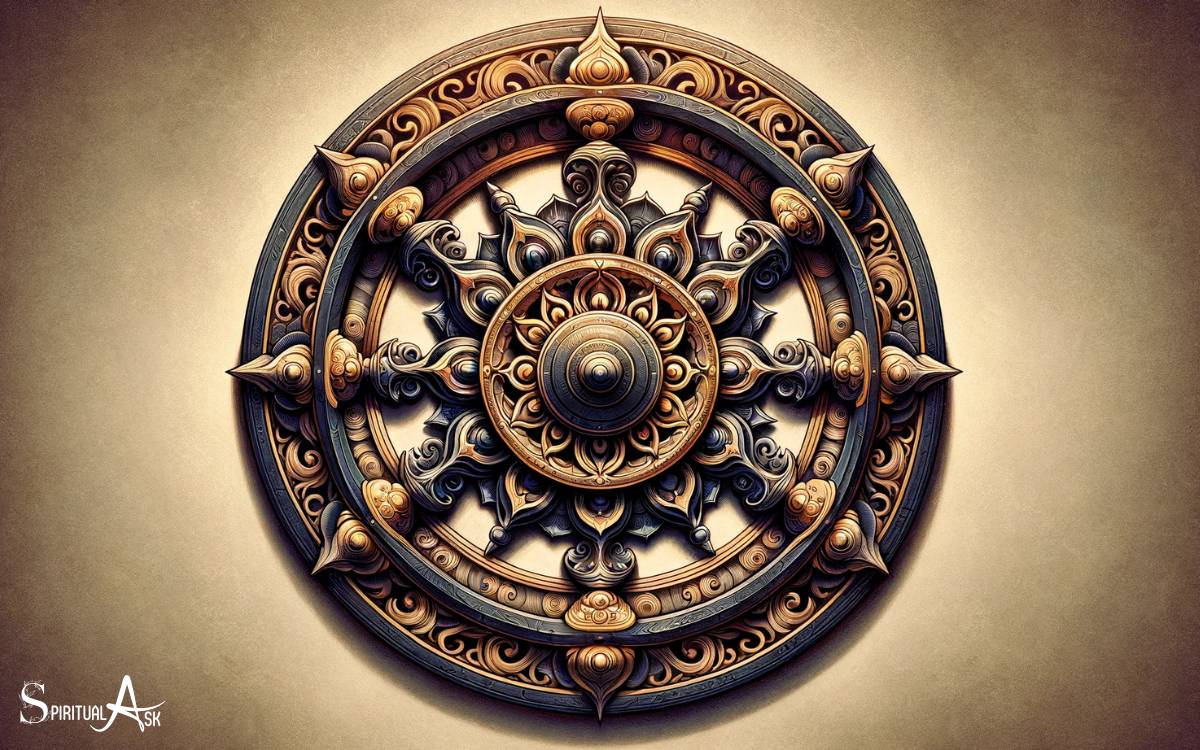
The spokes represent various aspects of Buddhist doctrine, such as ethical conduct, mindfulness, and wisdom.
As the wheel turns, it signifies the never-ending cycle of samsara, the continuous cycle of birth, life, death, and rebirth.
This symbol serves as a reminder of the interconnected nature of all things and the importance of following the Buddha’s teachings to attain liberation from suffering.
The Bodhi Tree
The Bodhi Tree holds great significance in Buddhist tradition. It is the very spot where Siddhartha Gautama, the Buddha, attained enlightenment.
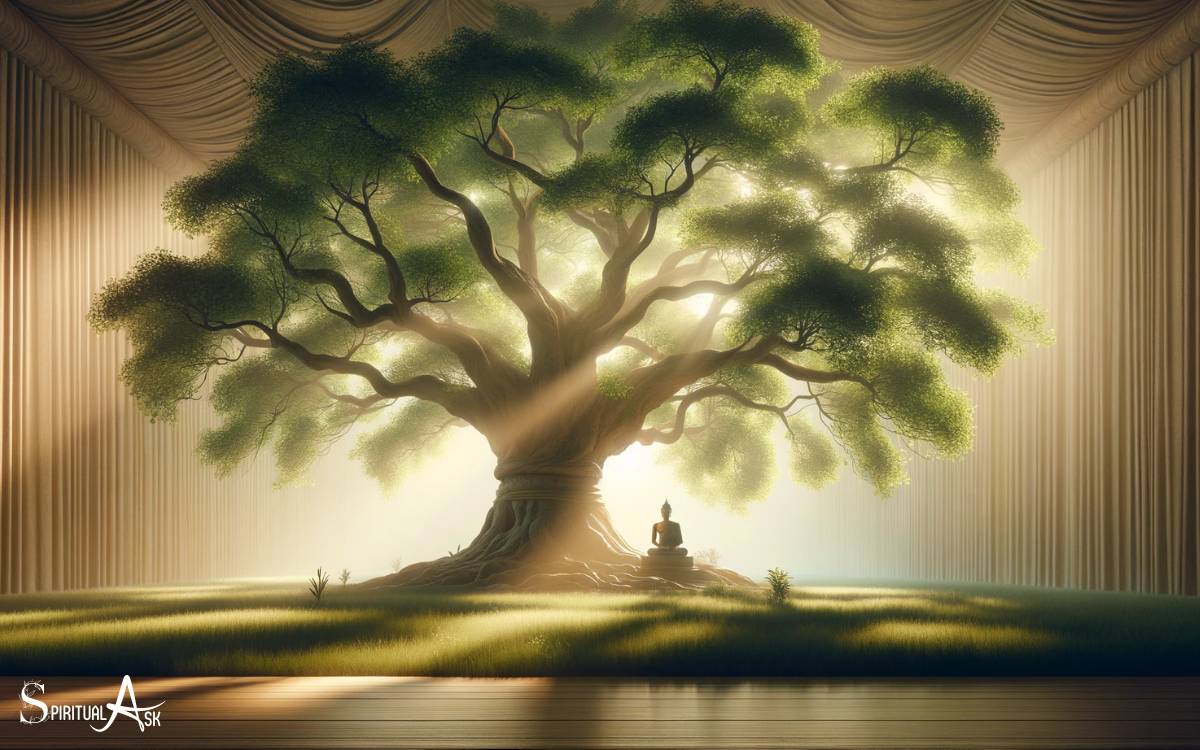
This sacred tree serves as a symbol of awakening and is a revered site for meditation and spiritual reflection.
Enlightenment Under Bodhi
I experienced profound enlightenment under the Bodhi tree, a transformative moment in my spiritual journey. It was a deeply spiritual and introspective experience, where I felt a profound sense of clarity and understanding.
The significance of this moment cannot be overstated, as it marked a turning point in my quest for spiritual awakening.
The Bodhi tree is a symbol of awakening and enlightenment in Buddhism. It is believed that Siddhartha Gautama, the Buddha, attained enlightenment while meditating under the Bodhi tree.
The Bodhi tree represents the potential for all beings to awaken to their true nature. Its canopy provides shade and a sense of tranquility, creating an ideal environment for meditation and self-reflection.
The Bodhi tree serves as a powerful reminder of the possibility of enlightenment for all who seek it.
This profound experience under the Bodhi tree led me to seek out other sacred Buddhist meditation sites for further spiritual growth and understanding.
Sacred Buddhist Meditation Site
After experiencing profound enlightenment under the Bodhi tree, I sought out other sacred Buddhist meditation sites for further spiritual growth and understanding.
The Bodhi tree holds a special place in Buddhist tradition as the site where Siddhartha Gautama, the Buddha, attained enlightenment. This sacred fig tree is not only a symbol of enlightenment but also a place of deep meditation and reflection.
Many Buddhists make pilgrimages to Bodhi trees around the world to meditate and seek spiritual awakening. The serene and peaceful ambiance surrounding these trees provides the perfect environment for introspection and mindfulness.
Sitting under a Bodhi tree, one can connect with the energy of enlightenment and gain a deeper understanding of Buddhist teachings. It is a place where one can embark on their own journey towards spiritual awakening.
Symbol of Awakening
Seeking further enlightenment, my journey from the sacred Bodhi tree leads to a deeper exploration of its symbolism as a powerful awakening symbol in Buddhist tradition.
The Bodhi tree represents:
- Awakening: The tree symbolizes the awakening of the Buddha, serving as a reminder of the potential for enlightenment within all beings.
- Inner Transformation: Its roots delve deep into the earth, reflecting the depth of inner transformation that leads to awakening.
- Endless Growth: Just as the Bodhi tree constantly grows and flourishes, it signifies the continuous growth and evolution of consciousness on the path to awakening.
The Bodhi tree’s significance goes beyond its physical presence, serving as a profound metaphor for the awakening of the human spirit.
This timeless symbol inspires us to seek enlightenment and embrace the potential for inner transformation and growth.
The Eternal Knot
I’ve always been fascinated by the intricate symbolism of the Eternal Knot in Buddhism. It serves as a powerful representation of interdependence, highlighting the interconnectedness of all things.
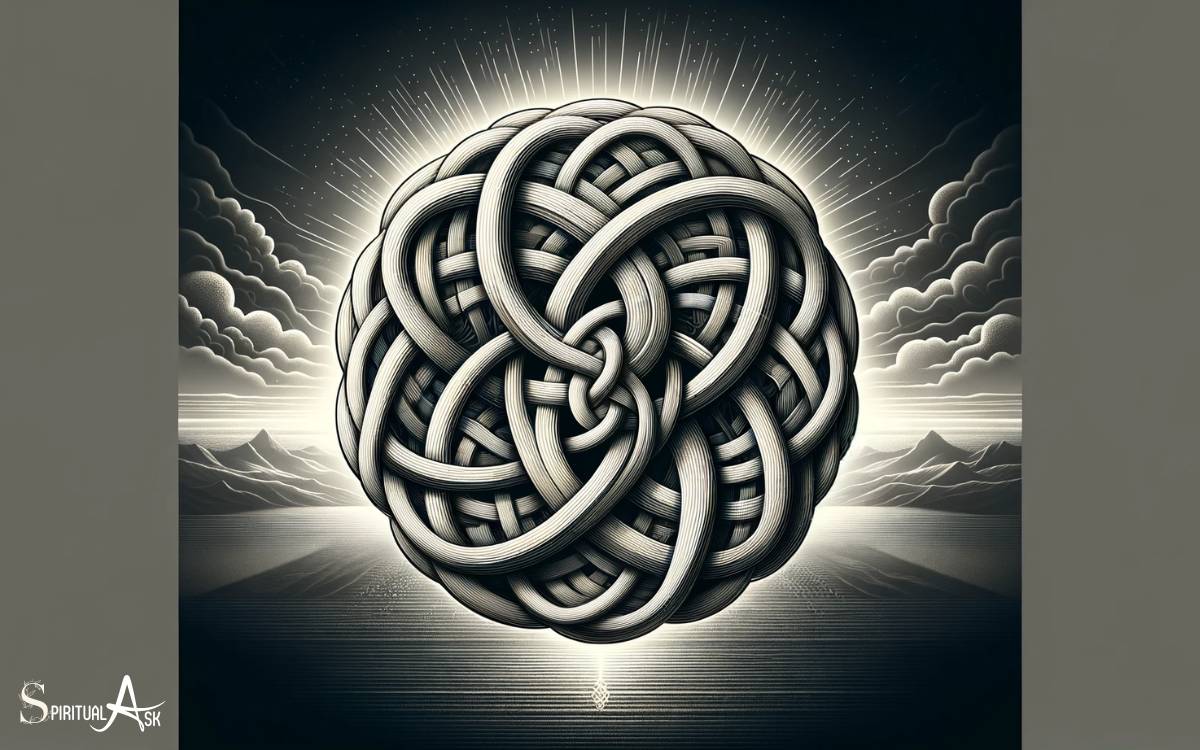
Moreover, it’s a profound reminder of the endless wisdom and eternal love that are integral to the Buddhist tradition.
Symbol of Interdependence
The Symbol of Interdependence, known as The Eternal Knot, represents the interconnectedness of all things in Buddhist philosophy.
This powerful symbol conveys the idea that all phenomena are interrelated, and every action has a consequence that ripples through the universe.
Here are some key points about this symbol:
- Interconnectedness: The Eternal Knot symbolizes the interwoven nature of reality, where everything is interconnected and dependent on each other.
- Cyclical Nature: It signifies the endless cycle of cause and effect, emphasizing the concept of karma and the interconnectedness of all beings.
- Unity and Harmony: It embodies the harmony and unity of all things, reminding us of our interconnectedness with the world around us.
- Endless Wisdom: The knot’s endless loops represent the wisdom of the Buddha, which has no beginning or end, highlighting the eternal nature of interconnectedness.
Represents Endless Wisdom
In exploring the symbolism of the Eternal Knot in Buddhism, I find it represents endless wisdom through its intricate and unending loops.
The Eternal Knot, also known as the Endless Knot, symbolizes the interconnectedness of wisdom and compassion, reflecting the intertwining nature of these virtues.
The unbroken lines signify the endless cycle of cause and effect, while the loops represent the seamless continuity of the teachings of Buddha, which are considered boundless and infinite.
This symbol serves as a reminder that wisdom has no beginning or end, and that the pursuit of knowledge is an ongoing, never-ending journey.
The Eternal Knot encourages us to seek wisdom in all aspects of life, fostering a deeper understanding of the interconnectedness of all things.
Signifies Eternal Love
As for me, within Buddhism, the Eternal Knot signifies an unbreakable bond between wisdom and compassion. This symbol represents the intertwining of these two essential qualities, creating a harmonious and everlasting connection.
When I contemplate the Eternal Knot, I am reminded of the inseparable nature of wisdom and compassion in the Buddhist tradition, and how they are integral to the path of enlightenment.
- The Eternal Knot symbolizes the infinite nature of love and compassion, emphasizing the interconnectedness of all beings.
- It serves as a reminder to cultivate boundless love and empathy towards oneself and others.
- This symbol also signifies the eternal nature of wisdom, highlighting the timeless knowledge that transcends worldly limitations.
- It encourages the pursuit of understanding and insight, leading to spiritual growth and enlightenment.
- The Eternal Knot serves as a visual representation of the inseparable union between wisdom and compassion, guiding practitioners towards the embodiment of these qualities in their spiritual journey.
The Conch Shell
One of the most important spiritual Buddhist symbols is represented by the Conch Shell. In Buddhism, the Conch Shell is a symbol of the teachings of the Buddha, which are said to be as far-reaching and melodious as the sound of the conch when it is blown.
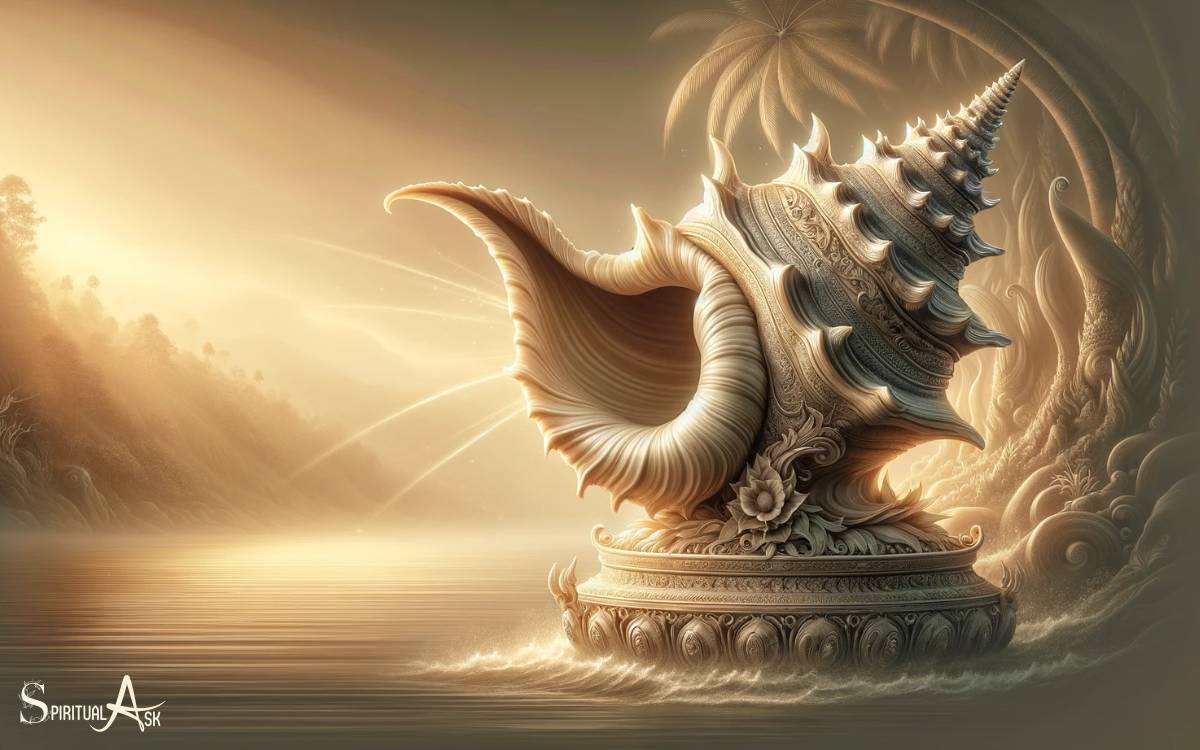
The conch’s spiral shape also represents the infinite nature of the teachings and the ceaseless effort to lead beings out of the sea of suffering.
Additionally, the conch is used in rituals to call practitioners to gather and listen to the teachings. Its significance is profound, reminding us of the power of the Buddha’s message and the importance of coming together to learn and grow.
The Eight Auspicious Symbols
The first symbol of the Eight Auspicious Symbols is the Lotus flower, symbolizing purity and enlightenment in Buddhism.
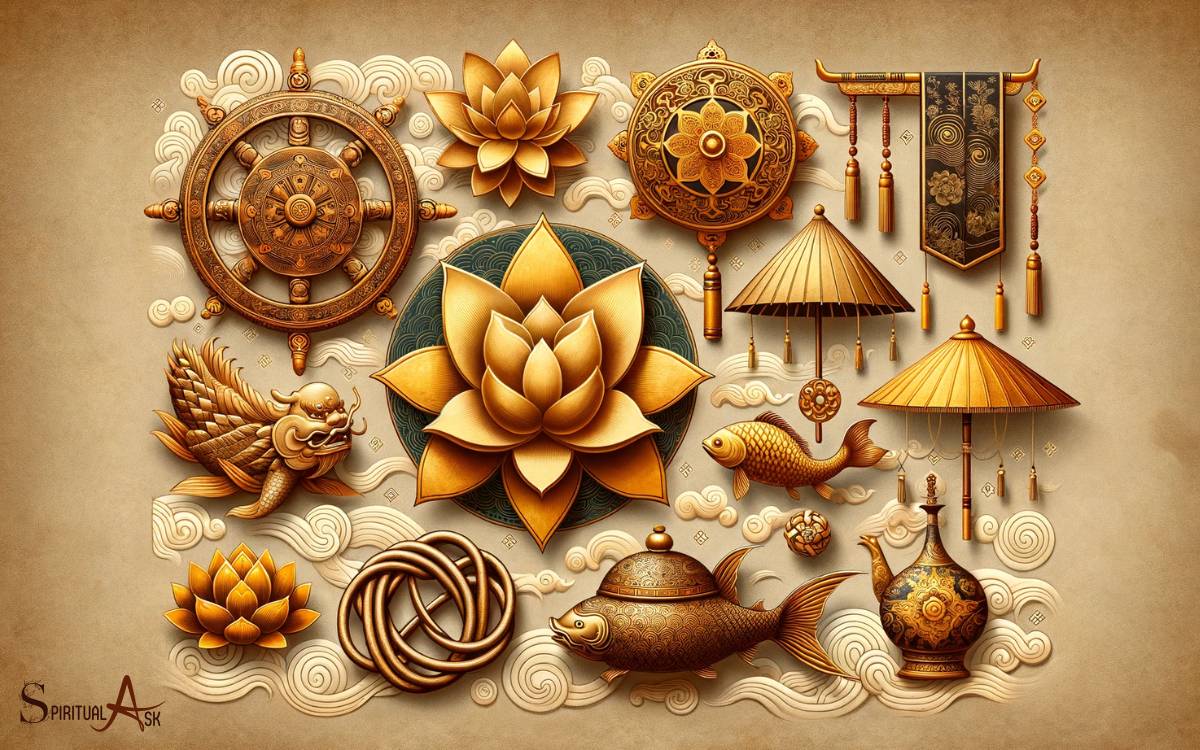
The Lotus is often depicted as a fully bloomed flower, emerging from muddy waters, representing the ability to rise above suffering and achieve spiritual growth.
As a Buddhist, I find the symbolism of the Lotus to be incredibly powerful. It reminds me that despite life’s challenges, I have the potential for inner transformation and beauty.
The other auspicious symbols include:
- The Endless Knot: Signifying the interconnectedness of all things
- It represents the endless cycle of birth, death, and rebirth
- The Golden Fishes: Symbolizing happiness, fertility, and abundance
- They are often depicted in pairs to represent harmony and conjugal happiness
- The Wheel of Dharma: Representing the teachings of Buddha and the path to enlightenment
- It symbolizes spiritual law and the cycle of birth, death, and rebirth.
Conclusion
As I journey through the intricate tapestry of spiritual Buddhist symbols and their meanings, I am reminded of the lotus flower, emerging from the muddy waters to symbolize purity and enlightenment.
Like the Dharma Wheel guiding us on the path to liberation, these symbols serve as beacons of wisdom and insight.
Just as the Bodhi Tree provided shelter to Buddha, these symbols offer refuge and inspiration to all who seek inner peace and harmony. Among these symbols, the palm tree stands out for its resilience and connection to the divine. In many cultures, the palm tree symbolism in spirituality represents victory, triumph, and peace, serving as a reminder that even in challenging times, one can rise above and flourish in the light of positivity. Through mindfulness and meditation, individuals can embrace the lessons of the palm tree, drawing strength from its enduring presence.

